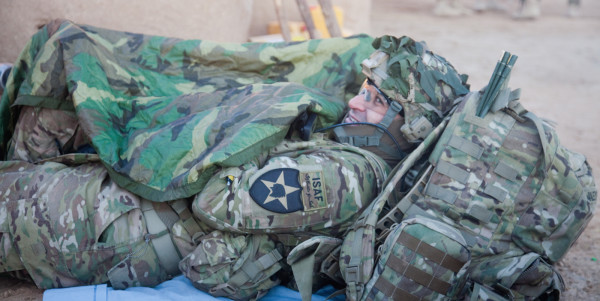

There have been some amazing military innovations over the years: freeze-dried food for MREs, jet aircraft, rail guns, and the soul-sucking website, Army Knowledge Online. But none of these compare to the simplest, most wonderful invention known to mankind: the poncho liner, affectionately known by all those who have felt its life-giving warmth as the “woobie.” Ask any soldier or Marine, especially those in the infantry, how he feels about his woobie, and his eyes will light up and then mist over as he waxes lyrically over the virtues of this item. Hard-bitten combat veterans grow poetic and wistful, declaring their love for this piece of equipment. If you don’t believe me, read the Amazon reviews. It is perhaps the single most-loved item in the armed forces.
What is it, and why does it inspire this fanatical devotion?
The “liner, wet weather, poncho” as it’s officially called, consists of two layers of nylon surrounding a polyester filling, sewn up along the sides and crosswise to ensure a very tough and durable piece of equipment. Army logistics manuals fail to say what magic spells are cast over poncho liners when they are made to make them so efficient at trapping heat in and keeping the cold out. They were originally produced in the 1960s, during the Vietnam War, when U.S. soldiers and Marines were engaged in jungle fighting. The troops needed a lightweight poncho to keep them relatively dry in the wet jungles and rice paddies, but also something to keep them warm during the cool nights. Thus the poncho and poncho liner were born. While the poncho liner was almost an afterthought to the poncho, it was the liner that would steal troops’ hearts.
The distinctive three-color camouflage pattern, that until only recently was the hallmark of all poncho liners, came from using recycled camouflaged parachute material left over from World War II. Even though the troops were wearing green fatigues, their poncho liners were of the mottled camo color. This continued even after recycled parachutes ceased to be used for the nylon covers of the poncho liners. Perhaps some of the grit and determination from the airborne troops of World War II leaked out from their chutes into the liners. Who can say? But upon their introduction, they became a huge hit.
So why is it called a woobie? What kind of silly name is that for a piece of high-speed, military-grade equipment? The origins of the term are lost in the mists of time, but many theories abound. One theory goes that it comes from the phrase, “Because you would be cold without it,” where “would be,” evolved into woobie. A similar version has it called a “willbie,” because, “It will be what keeps you from freezing.” Another theory comes from a bit of pop culture, where the term came from the 1983 Michael Keaton movie, “Mr. Mom,” in which the child calls his security blanket his woobie. Is this a case of the military mimicking pop culture or vice versa? Perhaps we will never know. Judging from the internet comments from veterans of the 1970s and 1980s, the term did not come into being until the 1990s, after the movie came out. Regardless, veterans of Afghanistan and Iraq have given the term credence, which is impressive, considering how silly it is.
No matter what you call it, is it really like a security blanket?
The answer is a resounding, “Hell yes!” A mere glance at veterans’ internet forums show a myriad of uses for this simple item. It can be used as a blanket, pillow, shelter, hammock, camo hide for concealment, jacket liner, seat cushion, mattress — when you are sleeping on the ground, anything helps — and something soft to hold onto when you’re far away from home and everything’s going to … well, you know, the stuff that hits the fan. It is remarkably resilient to extreme heat and cold, dries quickly when wet, and most importantly, can be squished up into a tiny ball that takes up barely any room in your rucksack and adds virtually no weight. I am still convinced it is magical.
Veterans often hang on to their woobies well after they leave the military, preferring to claim it as a “field loss” and pay the charges rather than turn it in. One vet claimed his woobie had outlasted several marriages, which probably says more about the stresses of military life than it does for the woobie, although many claim that woobies go missing in divorces. Young men in the military claim that “girls love it and think the term woobie is cute,” and so it is often used to begin a romantic relationship. Kids love the woobie because it is light, soft, reminds them of their mom or dad, and can be used as a cape when running around pretending to be a superhero. Many woobies get passed on through generations of veterans, with some troops deploying to Iraq or Afghanistan with their dads’ woobies from Vietnam.
Is it odd that there is so much love for such a simple item? Perhaps, but there is much in the military that might seem odd to people outside of it. The woobie is synonymous with comfort, and after a long, wet day on patrol, there’s nothing better than to crawl into something warm, dry, and soft, and have that moment of relief. Far from home on deployment, pulling your woobie around your shoulders gives a sense of safety that is quite often absent. Simply put, it is the greatest thing to ever be issued by the U.S. military.
The woobie: never leave home without it.
